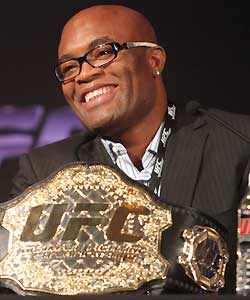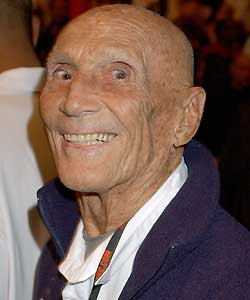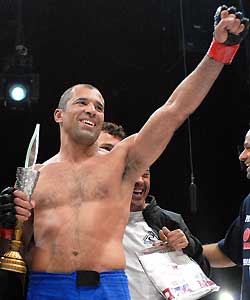MMA to return to Brazilian roots for UFC 134
There are many who consider Brazil the birthplace of mixed martial arts, but on Aug. 27, when UFC returns to the country after a 13-year absence with a show at the HSBC Arena in Rio de Janeiro, it will be presenting something far different from the legendary vale tudo matches that are the sport's roots.
As far as where the sport started, like most early sports histories, there is a combination of fuzzy memories and legends passed down by generations. The idea of mixed styles fighting may really date back to the sport of Pankration at the original Olympics in Greece some 2,800 years ago. There were also fights of this type in the late 1800s in Japan. But the UFC itself was the brainchild of Rorion Gracie, son of Helio Gracie, a sports legend in Brazil for his vale tudo fights dating back to 1930. The term translates roughly from Portuguese as "anything goes."
While coming to Rio de Janeiro was hardly a business miscalculation, UFC President Dana White now looks at this in one sense that he blew something of incredible potential. He underestimated the appeal.
"This fight in Rio, in the city, they’re talking about the major sports events in Rio, the Olympics, the World Cup and the UFC," he said. "We went on sale with 14,000 tickets and sold out right away. The first day, they had 350,000 phone calls from people wanting tickets. We could have done the soccer stadium. We’d come off Toronto (where they sold out the Rogers Centre with 56,000 fans), but I got scared and (wimped) out. We blew it. It could have been something crazy."
UFC 134, in other words, could have been a bigger money-maker than it will be.
"The thing is in Rio, when you have an event, like a rock concert, they sell so many tickets it’s ridiculous," said Kid Peligro, a jiu-jitsu historian. "It becomes a happening. It’s like, you have to be there, it’s a must-see thing. Anyone who is anyone has to be there. With this show, it’s a combination of the popularity of the sport and it being a big event. Brazil is very trendy."
But it was nothing like this some 80 years ago in what can be called the infancy of the sport.
"In 1930 in Brazil, it was still, 'The Law of the Strongest Man,' " said Pedro Valente, a ninth-degree red belt under Helio Gracie and a vale tudo historian. "So they would use jiu-jitsu to teach that the strongest man doesn’t always win the fight."
These early fights were not held with blaring music or TV cameras. There was no big money at stake. Except during the heydays of the 1930s and again from 1950 to 1962, the fights usually took place in small buildings, and sometimes empty gyms. The biggest fights were often held in private to avoid being shut down by the authorities.
During its popularity peak, fights would be held sometimes in large outdoor soccer stadiums, sometimes without a ring (cages didn't exist). Other times, fights were held on basketball courts, where fighters would be taken down and thrown on hardwood floors.
During most of the last 80 years, the media and the government wanted the events banned. Often, the promoters had to earmark money to charities or be forced to shut down. At various periods, they were outright banned.
But the sport created two fighting legends, Helio Gracie, who was by many accounts Rio de Janeiro’s local sports hero even though his sport was often not in any kind of spotlight, and Helio’s nephew, Carlson, a generation later. Carlson never achieved the notoriety of Helio because in his athletic prime the fights were banned in Rio de Janeiro, and he was forced to have many of his biggest fights in the northeast of Brazil, which didn’t get nearly as much attention.
The roots started at the turn of the 20th century. Mitsuya Maeda, a 5-foot-4, 145 pound judo/jiu-jitsu specialist (at the time judo and jiu-jitsu were terms for essentially the same art, before both separated and became sports with a different set of rules) toured the world as a pro wrestler and martial arts instructor. He did both real and fake fights, billed as world judo and world jiu-jitsu champion.
At the time, those terms were interchangeable for essentially anything goes non-striking fighting, basically today’s submission grappling. It wasn’t long after that point that judo and jiu-jitsu became separate sports with specific rules and point systems, veering away from either being true free fighting.
Maeda, better known as Conde Koma, was an expert both in the Japanese free fighting styles and in catch wrestling, a submission wrestling art from Europe. He wound up in Brazil and met Gastao Gracie, who hired Maeda to teach his techniques to his oldest son, Carlos. At the time, similar to the U.S. as late as the early 1990s, most Brazilians believed boxing was the ultimate in fighting.
Carlos taught his brothers what he'd learned. The youngest, Helio, a frail teenager, would observe and constantly think of new wrinkles. At about 155 pounds, Helio became the unlikely fighting star of the family a few years later. By the 1930s, judo was more about using leverage and technique for a smaller man to throw a bigger man to the ground. Jiu-jitsu was more about using submissions to finish a man once he got to the ground.
In many ways, Helio was very much like his son Royce, the first UFC star. His fame came because he was skinny and by the looks of him, nobody would think he was a fighter. But because of his understanding of what a real fight was, he could overcome people who didn’t have that knowledge.
Just as Royce was like Helio, Rorion is similar to Carlos. Rorion, one of the original founders of the UFC in 1993, had his skinny younger brother Royce fight far more physically imposing men billed as world champions from other sports, and when his brother would win, it would push the family’s business of teaching their techniques.
One could argue the origin of a modern mixed martial arts dates back to Jan. 16, 1932 in Rio de Janeiro, promoted by Carlos, who billed his new sport "Lutas Mistas," which translated, means "Mixed Fight." They fought in a boxing ring, and the competitors wore four-ounce boxing gloves, fascinating because it was a few years after UFC started in the U.S. before similar gloves became the norm.
"Since the type of event was controversial, the authorities didn’t like it," noted Valente, who has a scrapbook filled with the newspaper clippings covering the fight. "Carlos organized and promoted it, and it was only allowed to happen because he said he would donate the proceeds to the Brazilian Olympic athletes to help pay for them to attend the 1932 Olympics in Los Angeles. That’s how the event was saved."
The event, pushed as Omori (a jiu-jitsu fighter) vs. Crespo (a boxer), was on a show filled with similar matchups. Helio, who was 19, fought in a preliminary fight against boxer Antonio Portugal. Helio took him down immediately and submitted him with an armbar in less than one minute. Helio came out of the first show as its biggest star, the skinny teenager who finished the boxer in seconds.
Helio had a number of big fights between 1932 and 1938, always against much larger men coming from other sports brought in from foreign countries billed as legitimate world wrestling champions, always giving up substantial size. He won some, and went to time-limit draws in others, but never lost.
Probably the most famous of his wins came against Dudu, billed as a Brazilian giant, in 1935. In the first move of the fight, Helio threw a kick to the face, almost identical to the kicks thrown by Lyoto Machida to Randy Couture, and Anderson Silva to Vitor Belfort earlier this year. Dudu then spit out two teeth. The fighters were not wearing mouthguards. They ended up going 19 minutes in of one of the most violent fights of the era, ending when Gracie faked another kick to the face, but instead kicked the body, breaking two of Dudu’s ribs.
Even while Helio Gracie was widely respected and revered, his sport was not. From the start, the media felt it should be banned, and a few years later it was.
Helio had a second heyday, coinciding with pro wrestling becoming big in the country. Masahiko Kimura, considered by many as the Babe Ruth of judo in Japan, the world champion who never lost in his sport since 1935, had been recruited and taught pro wrestling in Hawaii, and became a big drawing card. A newspaper in Brazil brought him and other judo champions in to start a pro wrestling promotion in 1951. The group became big in Rio de Janeiro, where Helio, 37 at this point, was teaching and was still a local sports hero remembered for his fights in the 1930s.
Gracie vs. Kimura was held at Maracanazinho Stadium and was a huge event at the time, drawing politicians, national media coverage and about 20,000 fans.
"Helio was so revered," Peligro said. "He was truly a national hero back then. All the politicians wanted to train with him and knew him, presidents, ministers, he was a national figure of the largest scale."
Kimura, who was bigger and more powerful, threw Gracie around for much of the match. Eventually he caught him in a hammerlock, a move, because of this match, that is called the Kimura in MMA. Gracie refused to tap, even though his tendons were ripping.
"I thought he would surrender immediately, but Helio would not tap the mat," wrote Kimura in his autobiography. "I had no choice but to keep twisting the arm. The stadium became quiet. The bone of his arm was coming close to the breaking point. Finally, the sound of bone breaking echoed throughout the stadium. Helio still would not surrender. His left arm was powerless. “Under this rule, I had no choice but to twist the arm again. There was plenty of time left. I twisted the left arm again. Another bone was broken. Helio still did not tap. When I tried to twist the arm once more, a white towel was thrown in."
Helio became a bigger legend in losing.
"People thought Kimura was a world sports superstar," said Peligro. "He let his arm be broken and wouldn’t tap. People saw him as a brave man."
Helio’s last famous match came on May 24, 1955, not at a soccer stadium with thousands of fans, but inside the ACM, basically a Brazilian version of a YMCA gym. He was 41, and faced arguably his toughest student, Waldemar Santana. Santana was at least 40 pounds heavier and a great athlete to boot. Santana had become a pro wrestling star and Helio hated the sport because it was fake. Helio fired him from the academy and Santana, bitter, started attacking Helio in the newspapers.
This was a private challenge match, behind closed doors, with only a few friends and the press invited. The day of the fight, Gracie was sick with the flu, and was told to postpone the fight for a few weeks. But he would only push it back a day or two. Santana knocked Gracie out with a kick to the head in a fight that lasted three hours and 45 minutes.
This loss was devastating to the family. Students left the Gracie Academy for a school Santana set up. Carlson, who had been Santana's close friend, was chosen by the family to exact revenge. Santana became an even bigger star from pro wrestling and knocking out Helio. The broad interest from this closed-door match enabled organizers to get vale tudo fights legalized. This led to a series of fights between Carlson and Santana.
The first and most famous took place on Aug. 3, 1956 at Maracanazinho Stadium before 40,000 fans. Carlson weighed 158 pounds and Santana weighed 195 pounds. It ended at 39 minutes when Santana’s corner threw in the towel. They fought several other times, either with Carlson winning or ending in time-limit draws.
Valente remembered being at one fight at a soccer stadium with the canvas on the grass. They fought way off the canvas. There was a dry moat about six feet wide and six feet deep around the perimeter of the field. The two fell into it. They continued fighting until officials pulled them both out. Then they started once again.
"If it were not for me, after I beat Waldemar Santana, the Gracies would be selling bananas in public market," said Carlson Gracie before his death in an interview with Full Contact Fighter.
Carlson became a well-known fighting star in Brazil, although he was never the national sports hero Helio was. Arguably the mainstream peak of the sport was from 1960-1962, when Carlson and Helio hosted a show called "Heroes of the Ring," which aired live vale tudo fights. The boom ended quickly after a fight with Joel Alberto Barreto against Vinagre which saw a television close-up of an armlock that led to Vinagre’s bone sticking through the skin in a compound fracture.
The sport once again was banned in Rio de Janeiro and didn’t come back until 1975 when Kung Fu and Karate had become popular based on Bruce Lee movies. Every few years there would be events, usually based on rivalries between the jiu-jitsu and luta livre factions. In 1993, when Royce Gracie won the first UFC tournament, the Brazilian media didn't even cover it. With 63 years of knowledge of what happens when you put a Brazilian jiu-jitsu fighter against an opponent unfamiliar with the art, Brazilians had come to expect that outcome.
In 1997, as the Brazilian jiu-jitsu vs. luta livre rivalry reached its boiling point, a show was held in a small gym between Renzo Gracie and Eugenio Tadeu. At the 14:45 mark, the lights went out, a full scale riot broke out and gunshots were fired. At the time, Brazilian jiu-jitsu was getting a bad reputation because there were constant street fights that made the newspapers. Once again the sport was banned in Rio de Janeiro. But this time, the forces against vale tudo had a surprising ally – Helio Gracie.
Helio, 83 at the time, was quoted saying it had got out of hand. He also lost interest in UFC when they added more rules and most importantly, added judges, which he was dead set against, and implemented time limits. Plus, in his mind, there was no longer a need for these fights. That’s the reason that in 1998, when UFC came to Brazil for the first time with a show headlined by Frank Shamrock vs. John Lober and Vitor Belfort vs. Wanderlei Silva, it was held in Sao Paolo, not Rio de Janeiro.
In the last few years, there has been a major resurgence of interest. The biggest reason was UFC becoming strong on television, combined with the success of Brazilian fighters, Belfort in particular.
"Vitor has been in the limelight in Brazil for a long time," said Peligro. "He fought in UFC Brazil when he knocked out Wanderlei. He’s been a star. He married a star (a famous Brazilian model/actress). He’s very popular from his fighting, but he’s very charismatic and good looking. Anderson (Silva) has been around almost as long and has had a good career, but he’s never been as exposed as Vitor. When Vitor was fighting in the UFC way back when, he was everywhere. He was on all the big talk shows, so he became a big deal."
The Anderson Silva vs. Belfort fight in February was a huge breakthrough as well, as it was promoted in Brazil as "The Fight of the Century," garnering far more interest in Brazil than any UFC event ever had. But even as late as last year, Brazil was not even on the UFC’s radar, figuring it was not economically worth going there. Once Brazil got the
2016 Olympics, everything changed and the event was scheduled.
Valente was actually the first pick to referee the first UFC show in 1993, but turned it down because he was the Secretary of Health in the Rio de Janeiro government and his superiors felt that type of event was something he should not participate in. After following the sport for seven decades, he sees the publicity as the show is a week away and notes it’s nothing like anything he’s ever seen before.
"Heavy promoted, TV, newspapers, everywhere," he said.
As far as how that compares to the '50s and the big show at the soccer stadiums?
"It’s very difficult to compare because of technology, this has radio, TV, all the papers," he said. "The media is completely different. But at that time, in Master Helio’s day, it was also very big."
Other popular stories on Yahoo! Sports:
Reporter who broke SMU scandal: 'Pony Express' fallout led to Miami scandal
Is Brady Quinn pushing Tim Tebow to third on the depth chart?
Kobe Bryant and Luke Walton sent thousands of bucks to laid-off Laker employees



